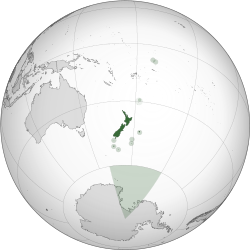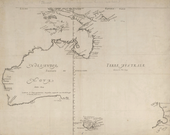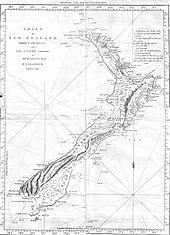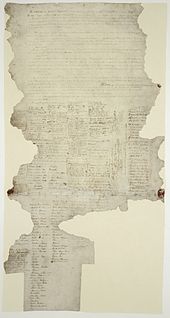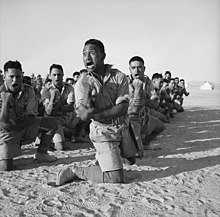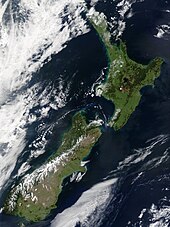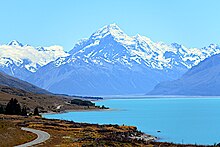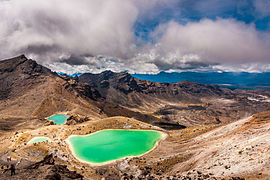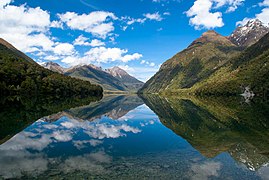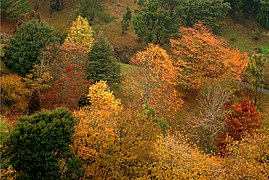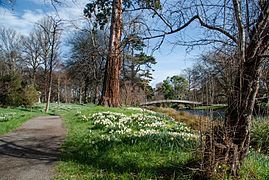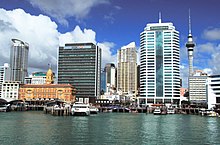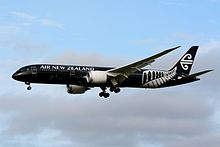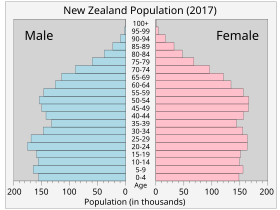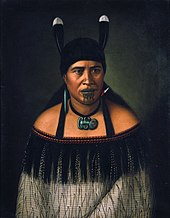New Zealand (
Māori:
Aotearoa [aɔˈtɛaɾɔa]) is a
sovereign island country in the southwestern
Pacific Ocean. The country geographically comprises two main landmasses—the
North Island (
Te Ika-a-Māui), and the
South Island (
Te Waipounamu)—and around 600
smaller islands. New Zealand is situated some 2,000 kilometres (1,200 mi) east of
Australia across the
Tasman Sea and roughly 1,000 kilometres (600 mi) south of the
Pacific island areas of
New Caledonia,
Fiji, and
Tonga. Because of its remoteness, it was one of the last lands to be settled by humans. During its long period of isolation, New Zealand developed a distinct
biodiversity of animal, fungal, and plant life. The country's varied topography and its sharp mountain peaks, such as the
Southern Alps, owe much to the
tectonic uplift of land and volcanic eruptions. New Zealand's
capital city is
Wellington, while its most populous city is
Auckland.
Sometime between 1250 and 1300,
Polynesians settled in the islands that later were named New Zealand and developed a distinctive
Māori culture. In 1642, Dutch explorer
Abel Tasman became the first European to sight New Zealand. In 1840, representatives of the United Kingdom and
Māori chiefs signed the
Treaty of Waitangi, which declared British sovereignty over the islands. In 1841, New Zealand
became a colony within the
British Empire and in 1907 it
became a dominion; it gained
full statutory independence in 1947 and the British monarch remained the
head of state. Today, the majority of
New Zealand's population of 4.9 million is of
European descent; the indigenous Māori are the largest minority, followed by
Asians and
Pacific Islanders. Reflecting this,
New Zealand's culture is mainly derived from Māori and early British settlers, with recent broadening arising from increased
immigration. The
official languages are
English,
Māori, and
NZ Sign Language, with English being very dominant.
A
developed country, New Zealand
ranks highly in international comparisons of national performance, such as quality of life, health, education, protection of
civil liberties, and
economic freedom. New Zealand underwent
major economic changes during the 1980s, which transformed it from a
protectionist to a
liberalised free-tradeeconomy. The service sector dominates the
national economy, followed by the industrial sector, and
agriculture; international
tourism is a significant source of revenue. Nationally, legislative authority is vested in an elected,
unicameral Parliament, while executive political power is exercised by the
Cabinet, led by the
prime minister, currently
Jacinda Ardern.
Queen Elizabeth II is the
country's monarch and is represented by a
governor-general, currently
Dame Patsy Reddy. In addition, New Zealand is organised into 11
regional councils and 67
territorial authorities for local government purposes. The
Realm of New Zealand also includes
Tokelau (a
dependent territory); the
Cook Islands and
Niue (self-governing states in
free association with New Zealand); and the
Ross Dependency, which is New Zealand's
territorial claim in Antarctica. New Zealand is a member of the
United Nations,
Commonwealth of Nations,
ANZUS,
Organisation for Economic Co-operation and Development,
ASEAN Plus Six,
Asia-Pacific Economic Cooperation, the
Pacific Community and the
Pacific Islands Forum.
Etymology

Detail from a 1657 map showing the western coastline of "Nova Zeelandia". (In this map, north is at the bottom.)
Aotearoa (pronounced
; often translated as "land of the long white cloud") is the current Māori name for New Zealand. It is unknown whether Māori had a name for the whole country before the arrival of Europeans, with
Aotearoa originally referring to just the
North Island. Māori had several traditional names for the two main islands, including
Te Ika-a-Māui (the fish of
Māui) for the North Island and
Te Waipounamu (the waters of
greenstone) or
Te Waka o Aoraki (the canoe of
Aoraki) for the
South Island. Early European maps labelled the islands North (North Island), Middle (South Island) and South (
Stewart Island / Rakiura).
[20] In 1830, maps began to use North and South to distinguish the two largest islands and by 1907 this was the accepted norm.
[16] The
New Zealand Geographic Board discovered in 2009 that the names of the North Island and South Island had never been formalised, and names and alternative names were formalised in 2013. This set the names as North Island or Te Ika-a-Māui, and South Island or Te Waipounamu.
[21] For each island, either its English or Māori name can be used, or both can be used together.
[21]
History
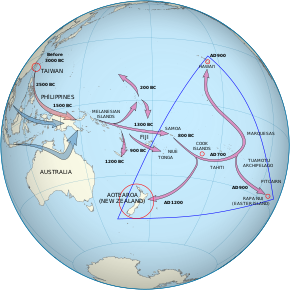
The
Māori people are most likely descended from people who emigrated from
Taiwan to
Melanesia and then travelled east through to the
Society Islands. After a pause of 70 to 265 years, a new wave of exploration led to the discovery and settlement of New Zealand.
[22]
New Zealand was one of the last major landmasses settled by humans.
Radiocarbon dating, evidence of
deforestation[23] and
mitochondrial DNA variability within
Māori populations
[24] suggest New Zealand was first settled by Eastern
Polynesians between 1250 and 1300,
[25] concluding a long series of voyages through the southern Pacific islands.
[26] Over the centuries that followed, these settlers developed a distinct culture now known as Māori. The population was divided into
iwi (tribes) and
hapū (subtribes) who would sometimes cooperate, sometimes compete and sometimes fight against each other.
[27] At some point a group of Māori migrated to
Rēkohu, now known as the
Chatham Islands, where they developed their distinct
Moriori culture.
[28][29] The Moriori population was all but wiped out between 1835 and 1862, largely because of
Taranaki Māori invasion and enslavement in the 1830s, although European diseases also contributed. In 1862 only 101 survived, and the last known full-blooded Moriori died in 1933.
[30]
An early map of
Australasiaduring the Golden Age of Dutch exploration (
c. 1590s – c.
1720s). Based on a chart by
Joan Blaeu, c.
1644.
Map of the New Zealand coastline as Cook charted it on his
first visit in 1769–70. The track of the
Endeavour is also shown.
The first
Europeans known to have reached New Zealand were Dutch explorer
Abel Tasman and his crew in 1642. In a hostile encounter, four crew members were killed and at least one Māori was hit by
canister shot.
[32] Europeans did not revisit New Zealand until 1769 when British explorer
James Cook mapped almost the entire coastline. Following Cook, New Zealand was visited by numerous European and North American
whaling,
sealing and trading ships. They traded European food, metal tools, weapons and other goods for timber, Māori food, artefacts and water. The introduction of the potato and the
musket transformed Māori agriculture and warfare. Potatoes provided a reliable food surplus, which enabled longer and more sustained military campaigns.
[34] The resulting intertribal
Musket Wars encompassed over 600 battles between 1801 and 1840, killing 30,000–40,000 Māori.
[35] From the early 19th century, Christian
missionaries began to settle New Zealand, eventually
converting most of the Māori population.
[36] The Māori population declined to around 40% of its pre-contact level during the 19th century; introduced diseases were the major factor.
[37]
In 1788 Captain
Arthur Phillip assumed the position of
Governor of the new British colony of
New South Wales which according to his commission included New Zealand.
[38] The British Government appointed
James Busby as British Resident to New Zealand in 1832 following a petition from northern Māori.
[39] In 1835, following an announcement of impending French settlement by
Charles de Thierry, the nebulous
United Tribes of New Zealand sent a
Declaration of Independence to King
William IV of the United Kingdom asking for protection.
[39] Ongoing unrest, the proposed settlement of New Zealand by the
New Zealand Company (which had already sent its first ship of surveyors to buy land from Māori) and the dubious legal standing of the Declaration of Independence prompted the
Colonial Office to send Captain
William Hobson to claim sovereignty for the United Kingdom and negotiate a treaty with the Māori.
[40] The
Treaty of Waitangi was first signed in the
Bay of Islandson 6 February 1840.
[41] In response to the New Zealand Company's attempts to establish an independent settlement in
Wellington[42] and French settlers purchasing land in
Akaroa,
[43] Hobson declared British sovereignty over all of New Zealand on 21 May 1840, even though copies of the Treaty were still circulating throughout the country for Māori to sign.
[44] With the signing of the Treaty and declaration of sovereignty the number of immigrants, particularly from the United Kingdom, began to increase.
[45]
New Zealand, still part of the colony of New South Wales, became a separate
Colony of New Zealand on 1 July 1841.
[46] The colony gained a
representative government in 1852 and the
first Parliament met in 1854.
[47] In 1856 the colony effectively became self-governing, gaining responsibility over all domestic matters other than
native policy.
[47] (Control over native policy was granted in the mid-1860s.
[47]) Following concerns that the South Island might form a separate colony, premier
Alfred Domett moved a resolution to transfer the
capital from Auckland to a locality near
Cook Strait.
[48] Wellington was chosen for its central location, with Parliament officially sitting there for the first time in 1865.
[49] As immigrant numbers increased, conflicts over land led to the
New Zealand Wars of the 1860s and 1870s, resulting in the loss and confiscation of much Māori land.
[50]
In 1907, at the request of the New Zealand Parliament, King
Edward VII proclaimed New Zealand a
Dominion within the British Empire,
[54] reflecting its self-governing status.
[55] In 1947 the country
adopted the
Statute of Westminster, confirming that the British Parliament could no longer legislate for New Zealand without the consent of New Zealand.
[47]
Government and politics
Elections since the 1930s have been dominated by two political parties,
National and
Labour.
[77] Between March 2005 and August 2006, New Zealand became the first country in the world in which all the highest offices in the land—head of state, governor-general, prime minister,
speakerand
chief justice—were occupied simultaneously by women.
[80] The current prime minister is
Jacinda Ardern, who has been in office since 26 October 2017.
[81] She is the country's third female prime minister.
[82]
New Zealand is identified as one of the world's most stable and well-governed states.
[86] As at 2017, the country was ranked fourth in the strength of its democratic institutions,
[87] and first in government transparency and
lack of corruption.
[88] A 2017
Human Rights Report by the U.S. Department of State noted that the government generally
respected the rights of individuals, but voiced concerns regarding the social status of the Māori population.
[89] New Zealand ranks highly for civic participation in the political process, with 77%
voter turnout during recent elections, compared to an
OECD average of 69%.
[90]
Foreign relations and military
Early colonial New Zealand allowed the British Government to determine external trade and be responsible for foreign policy.
[91] The 1923 and 1926
Imperial Conferences decided that New Zealand should be allowed to negotiate its own political
treaties and the first commercial treaty was ratified in 1928 with Japan. On 3 September 1939 New Zealand allied itself with Britain and
declared war on Germany with Prime Minister
Michael Joseph Savage proclaiming, "Where she goes, we go; where she stands, we stand."
[92]
In 1951 the United Kingdom became increasingly focused on its European interests,
[93] while New Zealand joined
Australia and the
United States in the
ANZUS security treaty.
[94] The influence of the United States on New Zealand weakened following protests over the
Vietnam War,
[95]the refusal of the United States to admonish France after the
sinking of the Rainbow Warrior,
[96] disagreements over environmental and agricultural trade issues and
New Zealand's nuclear-free policy.
[97][98] Despite the United States' suspension of ANZUS obligations the treaty remained in effect between New Zealand and Australia, whose foreign policy has followed a similar historical trend.
[99] Close political contact is maintained between the two countries, with
free trade agreements and
travel arrangements that allow citizens to visit, live and work in both countries without restrictions.
[100] In 2013 there were about 650,000 New Zealand citizens living in Australia, which is equivalent to 15% of the resident population of New Zealand.
[101]

Anzac Day service at the National War Memorial
In addition to Vietnam and the two world wars, New Zealand fought in the
Second Boer War,
[116] the
Korean War,
[117] the
Malayan Emergency,
[118] the
Gulf War and the
Afghanistan War. It has contributed forces to several regional and global peacekeeping missions, such as those in
Cyprus,
Somalia,
Bosnia and Herzegovina, the
Sinai,
Angola,
Cambodia, the
Iran–Iraq border,
Bougainville,
East Timor, and the
Solomon Islands.
[119]
Local government and external territories
The early European settlers divided New Zealand into
provinces, which had a degree of autonomy.
[120] Because of financial pressures and the desire to consolidate railways, education, land sales and other policies, government was centralised and the provinces were abolished in 1876.
[121] The provinces are remembered in
regional public holidays[122] and sporting rivalries.
[123]
Since 1876, various councils have administered local areas under legislation determined by the central government.
[120][124] In 1989, the government reorganised local government into the current two-tier structure of
regional councils and
territorial authorities.
[125] The
249 municipalities[125] that existed in 1975 have now been consolidated into 67 territorial authorities and 11 regional councils.
[126] The regional councils' role is to regulate "the natural environment with particular emphasis on
resource management",
[125] while territorial authorities are responsible for sewage, water, local roads, building consents and other local matters.
[128] Five of the territorial councils are
unitary authorities and also act as regional councils.
[128] The territorial authorities consist of 13 city councils, 53
district councils, and the
Chatham Islands Council. While officially the Chatham Islands Council is not a unitary authority, it undertakes many functions of a regional council.
[129]
The Realm of New Zealand, one of 16
Commonwealth realms,
[130] is the entire area over which the Queen of New Zealand is
sovereign, and comprises New Zealand,
Tokelau, the
Ross Dependency, the
Cook Islands and
Niue.
[65] The Cook Islands and Niue are self-governing states in
free association with New Zealand.
[131][132] The New Zealand Parliament cannot pass legislation for these countries, but with their consent can act on behalf of them in foreign affairs and defence. Tokelau is classified as a
non-self-governing territory, but is administered by a council of three elders (one from each Tokelauan
atoll).
[133] The Ross Dependency is New Zealand's
territorial claim in Antarctica, where it operates the
Scott Base research facility.
[134] New Zealand nationality law treats all parts of the realm equally, so most people born in New Zealand, the Cook Islands, Niue, Tokelau and the Ross Dependency are New Zealand citizens.
[135][n 7]
| show
Administrative divisions of the Realm of New Zealand
|
|---|
Environment
Geography
The Southern Alps stretch for 500 kilometres down the South Island
New Zealand is long and narrow (over 1,600 kilometres (990 mi) along its north-north-east axis with a maximum width of 400 kilometres (250 mi)),
[141] with about 15,000 km (9,300 mi) of coastline
[142] and a total land area of 268,000 square kilometres (103,500 sq mi).
[143] Because of its far-flung outlying islands and long coastline, the country has extensive marine resources. Its
exclusive economic zone is one of the largest in the world, covering more than 15 times its land area.
[144]
The South Island is the largest landmass of New Zealand and is the
12th largest island in the world. It is divided along its length by the
Southern Alps.
[145] There are 18 peaks over 3,000 metres (9,800 ft), the highest of which is
Aoraki / Mount Cook at 3,754 metres (12,316 ft).
Fiordland's steep mountains and deep
fiords record the extensive ice age glaciation of this southwestern corner of the South Island.
[147] The North Island is the
14th largest island in the world and is less mountainous but is
marked by volcanism.
[148] The highly active
Taupo Volcanic Zone has formed a large
volcanic plateau, punctuated by the North Island's highest mountain,
Mount Ruapehu (2,797 metres (9,177 ft)). The plateau also hosts the country's largest lake,
Lake Taupo,
[149] nestled in the
caldera of one of the world's most active
supervolcanoes.
[150]
New Zealand is part of a region known as
Australasia, together with Australia.
[154] It also forms the southwestern extremity of the geographic and ethnographic region called
Polynesia.
[155] The term
Oceania is often used to denote the wider region encompassing the
Australian continent, New Zealand and various islands in the Pacific Ocean that are not included in the
seven-continent model.
[156]
- Landscapes of New Zealand
-
-
-
-
Climate
New Zealand's climate is predominantly temperate
maritime (
Köppen: Cfb), with mean annual temperatures ranging from 10 °C (50 °F) in the south to 16 °C (61 °F) in the north.
[157] Historical
maxima and minima are 42.4 °C (108.32 °F) in
Rangiora,
Canterbury and −25.6 °C (−14.08 °F) in
Ranfurly,
Otago.
[158] Conditions vary sharply across regions from extremely wet on the
West Coast of the South Island to almost
semi-arid in
Central Otago and the
Mackenzie Basin of inland Canterbury and
subtropical in
Northland.
[159] Of the seven largest cities,
Christchurch is the driest, receiving on average only 640 millimetres (25 in) of rain per year and Wellington the wettest, receiving almost twice that amount.
[160] Auckland, Wellington and Christchurch all receive a yearly average of more than 2,000 hours of sunshine. The southern and southwestern parts of the South Island have a cooler and cloudier climate, with around 1,400–1,600 hours; the northern and northeastern parts of the South Island are the sunniest areas of the country and receive about 2,400–2,500 hours.
[161] The general snow season is early June until early October, though
cold snaps can occur outside this season.
[162] Snowfall is common in the eastern and southern parts of the South Island and mountain areas across the country.
[157]
The table below lists climate normals for the warmest and coldest months in New Zealand's six largest cities. North Island cities are generally warmest in February. South Island cities are warmest in January.
Biodiversity
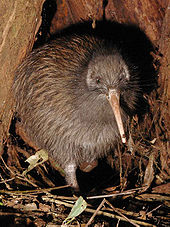
The endemic flightless
kiwiis a national icon.
New Zealand's
geographic isolation for 80 million years
[164] and island
biogeography has influenced evolution of the country's species of
animals,
fungi and
plants. Physical isolation has caused biological isolation, resulting in a dynamic evolutionary ecology with examples of very distinctive plants and animals as well as populations of widespread species.
[165][166] About 82% of New Zealand's indigenous
vascular plants are
endemic, covering 1,944 species across 65
genera.
[167][168] The number of fungi recorded from New Zealand, including lichen-forming species, is not known, nor is the proportion of those fungi which are endemic, but one estimate suggests there are about 2,300 species of lichen-forming fungi in New Zealand
[167] and 40% of these are endemic.
[169] The two main types of forest are those dominated by broadleaf trees with emergent
podocarps, or by
southern beech in cooler climates.
[170] The remaining vegetation types consist of grasslands, the majority of which are
tussock.
[171]
Before the arrival of humans, an estimated 80% of the land was covered in forest, with only
high alpine, wet, infertile and volcanic areas without trees.
[172] Massive
deforestation occurred after humans arrived, with around half the forest cover lost to fire after Polynesian settlement.
[173] Much of the remaining forest fell after European settlement, being logged or cleared to make room for pastoral farming, leaving forest occupying only 23% of the land.
[174]

The giant
Haast's eagle died out when humans hunted its main prey, the
moa, to extinction.
Other indigenous animals are represented by reptiles (
tuatara,
skinks and
geckos),
frogs,
[178] spiders,
[179] insects (
weta)
[180] and snails.
[181] Some, such as the tuatara, are so unique that they have been called
living fossils.
[182] Three species of bats (
one since extinct) were the only sign of native land mammals in New Zealand until the 2006 discovery of bones from
a unique, mouse-sized land mammal at least 16 million years old.
[183][184] Marine mammals however are abundant, with almost half the world's
cetaceans (whales, dolphins, and
porpoises) and large numbers of
fur seals reported in New Zealand waters.
[185] Many seabirds breed in New Zealand, a third of them unique to the country.
[186] More
penguin species are found in New Zealand than in any other country.
[187]
Since human arrival, almost half of the country's vertebrate species have become extinct, including at least fifty-one birds, three frogs, three lizards, one freshwater fish, and one bat. Others are endangered or have had their range severely reduced.
[176] However, New Zealand conservationists have pioneered several methods to help threatened wildlife recover, including island sanctuaries, pest control, wildlife translocation, fostering, and ecological
restoration of islands and
other selected areas.
[188][189][190][191]
Economy
Historically, extractive industries have contributed strongly to New Zealand's economy, focussing at different times on sealing, whaling,
flax, gold,
kauri gum, and native timber.
[195] The first shipment of refrigerated meat on the
Dunedin in 1882 led to the establishment of meat and dairy exports to Britain, a trade which provided the basis for strong economic growth in New Zealand.
[196] High demand for agricultural products from the United Kingdom and the United States helped New Zealanders achieve higher living standards than both Australia and Western Europe in the 1950s and 1960s.
[197] In 1973, New Zealand's export market was reduced when the United Kingdom joined the
European Economic Community[198] and other compounding factors, such as the
1973 oil and
1979 energy crises, led to a severe
economic depression.
[199] Living standards in New Zealand fell behind those of Australia and Western Europe, and by 1982 New Zealand had the lowest per-capita income of all the developed nations surveyed by
the World Bank.
[200] In the mid-1980s New Zealand deregulated its
agricultural sector by phasing out
subsidies over a three-year period.
[201][202] Since 1984, successive governments engaged in major
macroeconomic restructuring (known first as
Rogernomics and then
Ruthanasia), rapidly transforming New Zealand from a
protected and highly regulated economy to a liberalised
free-trade economy.
[203][204]
Unemployment peaked above 10% in 1991 and 1992,
[206] following the
1987 share market crash, but eventually fell to a record low (since 1986) of 3.7% in 2007 (ranking third from twenty-seven comparable OECD nations).
[206] However, the
global financial crisis that followed had a major impact on New Zealand, with the GDP shrinking for five consecutive quarters, the longest recession in over thirty years,
[207][208] and unemployment rising back to 7% in late 2009.
[209] Unemployment rates for different age groups follow similar trends, but are consistently higher among youth. In the December 2014 quarter, the general unemployment rate was around 5.8%, while the unemployment rate for youth aged 15 to 21 was 15.6%.
[206] New Zealand has experienced a series of "
brain drains" since the 1970s
[210] that still continue today.
[211] Nearly one quarter of highly skilled workers live overseas, mostly in Australia and Britain, which is the largest proportion from any developed nation.
[212] In recent decades, however, a "brain gain" has brought in educated professionals from Europe and less developed countries.
[213] Today New Zealand's economy benefits from a high level of
innovation.
[215]
Trade
New Zealand is heavily dependent on international trade,
[216] particularly in agricultural products.
[217] Exports account for 24% of its output,
[142] making New Zealand vulnerable to international commodity prices and global
economic slowdowns. Food products made up 55% of the value of all the country's exports in 2014; wood was the second largest earner (7%).
[218] New Zealand's main trading partners, as at June 2018, are China (
NZ$27.8b), Australia ($26.2b), the
European Union ($22.9b), the United States ($17.6b), and Japan ($8.4b).
[219] On 7 April 2008, New Zealand and China signed the
New Zealand–China Free Trade Agreement, the first such agreement China has signed with a developed country.
[220] The service sector is the largest sector in the economy, followed by manufacturing and construction and then farming and raw material extraction.
[142] Tourism plays a significant role in the economy, contributing $12.9 billion (or 5.6%) to New Zealand's total GDP and supporting 7.5% of the total workforce in 2016.
[221] International visitor arrivals are expected to increase at a rate of 5.4% annually up to 2022.
[221]
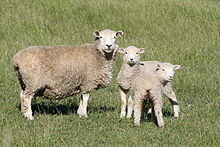
Wool has historically been one of New Zealand's major exports.
Wool was New Zealand's major agricultural export during the late 19th century.
[195] Even as late as the 1960s it made up over a third of all export revenues,
[195] but since then its price has steadily dropped relative to other commodities
[222] and wool is no longer profitable for many farmers.
[223]In contrast
dairy farming increased, with the number of dairy cows doubling between 1990 and 2007,
[224] to become New Zealand's largest export earner.
[225] In the year to June 2018, dairy products accounted for 17.7% ($14.1 billion) of total exports,
[219] and the country's largest company,
Fonterra, controls almost one-third of the international dairy trade.
[226] Other exports in 2017-18 were meat (8.8%), wood and wood products (6.2%), fruit (3.6%), machinery (2.2%) and wine (2.1%).
[219] New Zealand's wine industry has followed a similar trend to dairy, the number of vineyards doubling over the same period,
[227] overtaking wool exports for the first time in 2007.
[228][229]
Infrastructure
The provision of
water supply and sanitation is generally of good quality. Regional authorities provide water abstraction, treatment and distribution infrastructure to most developed areas.
[231][232]
New Zealand's transport network comprises 94,000 kilometres (58,410 mi) of roads, including 199 kilometres (124 mi) of motorways,
[233] and 4,128 kilometres (2,565 mi) of railway lines.
[142] Most major cities and towns are linked by bus services, although the private car is the predominant mode of transport.
[234] The
railways were privatised in 1993, but were re-nationalised by the government in stages between 2004 and 2008. The state-owned enterprise
KiwiRail now operates the railways, with the exception of commuter services in Auckland and Wellington which are operated by
Transdev[235] and
Metlink,
[236] respectively. Railways run the length of the country, although most lines now carry freight rather than passengers.
[237] Most international visitors arrive via air
[238] and New Zealand has
six international airports, but currently only the
Auckland and
Christchurch airports connect directly with countries other than Australia or Fiji.
[239]
Demography
The
2013 New Zealand census enumerated a resident population of 4,242,048, an increase of 5.3% over the 2006 figure.
[244][n 8] As of May 2019, the total population has risen to an estimated 4,964,490.
[5] In 2018 the
median age of the New Zealand population was 38.1 years.
[246]
Life expectancy for New Zealanders in 2012 was 84 years for females, and 80.2 years for males.
[249] Life expectancy at birth is forecast to increase from 80 years to 85 years in 2050 and infant mortality is expected to decline.
[250] New Zealand's
fertility rate of 2.1 is relatively high for a developed country, and natural births account for a significant proportion of
population growth. Consequently, the country has a young population compared to most industrialised nations, with 20% of New Zealanders being 14 years old or younger.
[142] By 2050 the median age is projected to rise from 36 years to 43 years and the percentage of people 60 years of age and older to rise from 18% to 29%.
[250] In 2008, the leading cause of premature death was
cancer, at 29.8%, followed by
ischaemic heart disease, 19.7%, and then
cerebrovascular disease, 9.2%.
[251] As of 2016, total expenditure on
health care (including private sector spending) is 9.2% of GDP.
[252]
Largest urban areas in New Zealand
|
|---|
| Rank | Name | Region | Pop. | Rank | Name | Region | Pop. | |
|---|

Auckland

Wellington | 1 | Auckland | Auckland | 1,628,900 | 11 | Whangarei | Northland | 58,800 | 
Christchurch

Hamilton |
| 2 | Wellington | Wellington | 418,500 | 12 | New Plymouth | Taranaki | 58,300 |
| 3 | Christchurch | Canterbury | 404,500 | 13 | Invercargill | Southland | 51,200 |
| 4 | Hamilton | Waikato | 241,200 | 14 | Kapiti | Wellington | 42,700 |
| 5 | Tauranga | Bay of Plenty | 141,600 | 15 | Whanganui | Manawatu-Wanganui | 40,900 |
| 6 | Napier-Hastings | Hawke's Bay | 134,500 | 16 | Gisborne | Gisborne | 37,200 |
| 7 | Dunedin | Otago | 122,000 | 17 | Blenheim | Marlborough | 31,600 |
| 8 | Palmerston North | Manawatu-Wanganui | 86,600 | 18 | Pukekohe | Auckland | 31,400 |
| 9 | Nelson | Nelson | 67,500 | 19 | Timaru | Canterbury | 29,100 |
| 10 | Rotorua | Bay of Plenty | 59,500 | 20 | Taupo | Waikato | 24,700 |
Ethnicity and immigration
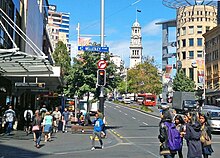
Pedestrians on
Queen Street in Auckland, an ethnically diverse city
In the 2013 census, 74.0% of New Zealand residents identified ethnically as European, and 14.9% as Māori. Other major ethnic groups include
Asian (11.8%) and Pacific peoples (7.4%), two-thirds of whom live in the
Auckland Region.
[3][n 3] The population has become more diverse in recent decades: in 1961, the census reported that the population of New Zealand was 92% European and 7% Māori, with Asian and Pacific minorities sharing the remaining 1%.
[254]
While the
demonym for a New Zealand citizen is New Zealander, the informal "
Kiwi" is commonly used both internationally
[255] and by locals.
[256] The Māori loanword
Pākehā has been used to refer to
New Zealanders of European descent, although others reject this appellation.
[258] The word Pākehā today is increasingly used to refer to all non-Polynesian New Zealanders.
[259]
The Māori were the first people to reach New Zealand, followed by the early
European settlers. Following colonisation, immigrants were predominantly from Britain, Ireland and Australia because of restrictive policies similar to the
White Australia policy.
[260] There was also significant Dutch,
Dalmatian,
[261] German, and Italian immigration, together with indirect European immigration through Australia, North America, South America and South Africa.
[262][263] Net migration increased after the Second World War; in the 1970s and 1980s policies were relaxed and immigration from Asia was promoted.
[263][264] In 2009–10, an annual target of 45,000–50,000 permanent residence approvals was set by the New Zealand Immigration Service—more than one new migrant for every 100 New Zealand residents.
[265] Just over 25% of New Zealand's population was born overseas, with the majority (52%) living in the Auckland Region. The United Kingdom remains the largest source of New Zealand's overseas population, with a quarter of all overseas-born New Zealanders born there; other major sources of New Zealand's overseas-born population are China, India, Australia, South Africa, Fiji and Samoa.
[266] The number of fee-paying
international students increased sharply in the late 1990s, with more than 20,000 studying in public
tertiary institutions in 2002.
[267]
Language
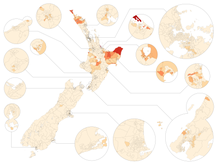
Speakers of Māori according to the 2013 census
[268]
Less than 5%
More than 5%
More than 10%
More than 20%
More than 30%
More than 40%
More than 50%
English is the predominant language in New Zealand, spoken by 96.1% of the population.
[269] New Zealand English is similar to
Australian English and many speakers from the Northern Hemisphere are unable to tell the
accents apart. The most prominent differences between the New Zealand English dialect and other English dialects are the shifts in the short front vowels: the short-"i" sound (as in "kit") has centralised towards the
schwa sound (the "a" in "comma" and "about"); the short-"e" sound (as in "dress") has moved towards the short-"i" sound; and the short-"a" sound (as in "trap") has moved to the short-"e" sound.
[271]
After the Second World War, Māori were discouraged from speaking their own language (
te reo Māori) in schools and workplaces and it existed as a community language only in a few remote areas.
[272] It has recently undergone a process of revitalisation,
[273] being declared one of New Zealand's official languages in 1987,
[274] and is spoken by 3.7% of the population.
[269][n 9] There are now Māori language immersion schools and two television channels that broadcast predominantly in Māori.
[276] Many places have both their Māori and English names officially recognised.
[277]
As recorded in the 2013 census,
[269] Samoan is the most widely spoken non-official language (2.2%),
[n 10] followed by
Hindi (1.7%), "Northern Chinese" (including
Mandarin, 1.3%) and French (1.2%). 20,235 people (0.5%) reported the ability to use
New Zealand Sign Language. It was declared one of New Zealand's official languages in 2006.
[278]
Religion

A
Rātana church on a hill near
Raetihi. The two-tower construction is characteristic of Rātana buildings.
Christianity is the predominant religion in New Zealand, although its society is among the most
secular in the world.
[279][280] In the 2013 census, 55.0% of the population identified with one or more religions, including 49.0% identifying as Christians. Another 41.9% indicated that they had no religion.
[n 11] The main Christian denominations are, by number of adherents,
Roman Catholicism (12.6%),
Anglicanism (11.8%),
Presbyterianism (8.5%) and "Christian not further defined" (i.e. people identifying as Christian but not stating the denomination, 5.5%). The Māori-based
Ringatū and
Rātana religions (1.4%) are also Christian in origin.
[282][283] Immigration and demographic change in recent decades has contributed to the growth of minority religions,
[284] such as
Hinduism (2.1%),
Buddhism (1.5%),
Islam (1.2%) and
Sikhism (0.5%).
[282] The Auckland Region exhibited the greatest religious diversity.
[282]
Education
Primary and secondary schooling is compulsory for children aged 6 to 16, with the majority attending from the age of 5.
[285] There are 13 school years and attending
state (public) schools is free to New Zealand citizens and permanent residents from a person's 5th birthday to the end of the calendar year following their 19th birthday.
[286] New Zealand has an adult literacy rate of 99%,
[142] and over half of the population aged 15 to 29 hold a tertiary qualification.
[285] There are five types of government-owned tertiary institutions: universities, colleges of education,
polytechnics, specialist colleges, and
wānanga,
[287] in addition to private training establishments.
[288] In the adult population 14.2% have a
bachelor's degree or higher, 30.4% have some form of secondary qualification as their highest qualification and 22.4% have no formal qualification.
[289] The OECD's
Programme for International Student Assessment ranks New Zealand's education system as the seventh best in the world, with students performing exceptionally well in reading, mathematics and science.
[290]
Culture
Late 20th-century house-post depicting the navigator
Kupe fighting two sea creatures
Early Māori adapted the tropically based east
Polynesian culture in line with the challenges associated with a larger and more diverse environment, eventually developing their own distinctive culture. Social organisation was largely communal with families (
whānau), subtribes (
hapū) and tribes (
iwi) ruled by a chief (
rangatira), whose position was subject to the community's approval. The British and Irish immigrants brought aspects of their own culture to New Zealand and also influenced Māori culture,
[292][293] particularly with the introduction of Christianity.
[294] However, Māori still regard their allegiance to tribal groups as a vital part of
their identity, and Māori kinship roles resemble
those of other Polynesian peoples.
[295] More recently
American,
Australian,
Asian and other
European cultures have exerted influence on New Zealand. Non-Māori Polynesian cultures are also apparent, with
Pasifika, the world's largest Polynesian festival, now an annual event in Auckland.
[296]

European settlers developed an identity that was influenced by their rustic lifestyle. In this scene from 1909, men at their camp site display a catch of rabbits and fish.
The largely rural life in early New Zealand led to the image of New Zealanders being rugged, industrious problem solvers. Modesty was expected and enforced through the "
tall poppy syndrome", where high achievers received harsh criticism. At the time New Zealand was not known as an intellectual country.
[299] From the early 20th century until the late 1960s, Māori culture was suppressed by the attempted
assimilation of Māori into British New Zealanders.
[272] In the 1960s, as tertiary education became more available and
cities expanded[300] urban culture began to dominate.
[301]However, rural imagery and themes are common in New Zealand's art, literature and media.
[302]
Art
As part of the resurgence of Māori culture, the traditional crafts of carving and weaving are now more widely practised and Māori artists are increasing in number and influence.
[304] Most Māori carvings feature human figures, generally with three fingers and either a natural-looking, detailed head or a grotesque head.
[305] Surface patterns consisting of spirals, ridges, notches and fish scales decorate most carvings.
[306] The pre-eminent Māori architecture consisted of carved meeting houses (
wharenui) decorated with symbolic carvings and illustrations. These buildings were originally designed to be constantly rebuilt, changing and adapting to different whims or needs.
[307]
Māori decorated the white wood of buildings, canoes and cenotaphs using red (a mixture of red
ochre and shark fat) and black (made from soot) paint and painted pictures of birds, reptiles and other designs on cave walls.
[308] Māori tattoos (
moko) consisting of coloured soot mixed with gum were cut into the flesh with a bone chisel.
[309] Since European arrival paintings and photographs have been dominated by landscapes, originally not as works of art but as factual portrayals of New Zealand.
[310] Portraits of Māori were also common, with early painters often portraying them as "
noble savages", exotic beauties or friendly natives.
[310] The country's isolation delayed the influence of European artistic trends allowing local artists to develop their own distinctive style of
regionalism.
[311] During the 1960s and 1970s many artists combined traditional Māori and Western techniques, creating unique art forms.
[312] New Zealand art and craft has gradually achieved an international audience, with exhibitions in the
Venice Biennale in 2001 and the "Paradise Now" exhibition in New York in 2004.
[304][313]
Māori cloaks are made of fine flax fibre and patterned with black, red and white triangles, diamonds and other geometric shapes.
[314] Greenstone was fashioned into earrings and necklaces, with the most well-known design being the
hei-tiki, a distorted human figure sitting cross-legged with its head tilted to the side.
[315] Europeans brought English fashion etiquette to New Zealand, and until the 1950s most people dressed up for social occasions.
[316] Standards have since relaxed and New Zealand fashion has received a reputation for being casual, practical and lacklustre.
[317][318] However, the local fashion industry has grown significantly since 2000, doubling exports and increasing from a handful to about 50 established labels, with some labels gaining international recognition.
[318]
Literature
Māori quickly adopted writing as a means of sharing ideas, and many of their oral stories and poems were converted to the written form.
[319] Most early English literature was obtained from Britain and it was not until the 1950s when local publishing outlets increased that New Zealand literature started to become widely known.
[320] Although still largely influenced by global trends (
modernism) and events (the Great Depression), writers in the 1930s began to develop stories increasingly focused on their experiences in New Zealand. During this period literature changed from a
journalistic activity to a more academic pursuit.
[321] Participation in the world wars gave some New Zealand writers a new perspective on New Zealand culture and with the post-war expansion of universities local literature flourished.
[322] Dunedin is a UNESCO
City of Literature.
[323]
Media and entertainment
New Zealand music has been influenced by
blues,
jazz,
country,
rock and roll and
hip hop, with many of these genres given a unique New Zealand interpretation.
[324] Māori developed traditional chants and songs from their ancient Southeast Asian origins, and after centuries of isolation created a unique "monotonous" and "
doleful" sound.
[325]Flutes and trumpets were used as musical instruments
[326] or as signalling devices during war or special occasions.
[327] Early settlers brought over their ethnic music, with
brass bands and
choral music being popular, and musicians began touring New Zealand in the 1860s.
[328][329] Pipe bands became widespread during the early 20th century.
[330] The New Zealand recording industry began to develop from 1940 onwards and many New Zealand musicians have obtained success in Britain and the United States.
[324] Some artists release Māori language songs and the Māori tradition-based art of
kapa haka (song and dance) has made a resurgence.
[331] The
New Zealand Music Awards are held annually by
Recorded Music NZ; the awards were first held in 1965 by
Reckitt & Colman as the
Loxene Golden Disc awards.
[332] Recorded Music NZ also publishes the country's
official weekly record charts.
[333]
Public
radio was introduced in New Zealand in 1922.
[335] A state-owned
television service began in 1960.
[336] Deregulation in the 1980s saw a sudden increase in the numbers of radio and television stations.
[337] New Zealand television primarily broadcasts American and British programming, along with a large number of Australian and local shows.
[338] The number of
New Zealand films significantly increased during the 1970s. In 1978 the
New Zealand Film Commission started assisting local film-makers and many films attained a world audience, some receiving international acknowledgement.
[337] The highest-grossing New Zealand films are
Hunt for the Wilderpeople,
Boy,
The World's Fastest Indian,
Once Were Warriors and
Whale Rider.
[339] The country's diverse scenery and compact size, plus government incentives,
[340] have encouraged some
producers to shoot big-budget productions in New Zealand, including
Avatar,
The Lord of the Rings,
The Hobbit,
The Chronicles of Narnia,
King Kongand
The Last Samurai.
[341] The New Zealand media industry is dominated by a small number of companies, most of which are foreign-owned, although the
state retains ownership of some television and radio stations.
[342] Since 1994,
Freedom House has consistently ranked New Zealand's press freedom in the top twenty, with the 19th freest media in 2015.
[343]
Sports
Most of the major sporting codes played in New Zealand have British origins.
[344] Rugby union is considered the
national sport[345] and attracts the most spectators.
[346] Golf,
netball,
tennis and
cricket have the highest rates of adult participation, while netball, rugby union and
football (soccer) are particularly popular among young people.
[346][347] Around 54% of New Zealand adolescents participate in sports for their school.
[347] Victorious rugby tours to Australia and the United Kingdom in the
late 1880s and the
early 1900s played an early role in instilling a national identity.
[348] Horseracing was also a popular
spectator sport and became part of the "Rugby, Racing and Beer" culture during the 1960s.
[349] Māori participation in European sports was particularly evident in rugby and the country's team performs a
haka, a traditional Māori challenge, before international matches.
[350] New Zealand is known for its
extreme sports,
adventure tourism and strong
mountaineering tradition, as seen in the success of notable New Zealander
Sir Edmund Hillary.
[352][353] Other outdoor pursuits such as
cycling, fishing, swimming, running,
tramping, canoeing, hunting, snowsports, surfing and sailing are also popular.
[354] The Polynesian sport of
waka ama racing has experienced a resurgence of interest in New Zealand since the 1980s.
[355]
Cuisine

Ingredients to be prepared for a
hāngi
The national cuisine has been described as
Pacific Rim, incorporating the native
Māori cuisine and diverse culinary traditions introduced by settlers and immigrants from Europe, Polynesia and Asia.
[361] New Zealand yields produce from land and sea—most crops and livestock, such as maize, potatoes and pigs, were gradually introduced by the early European settlers.
[362] Distinctive ingredients or dishes include
lamb, salmon,
kōura (crayfish),
[363] dredge oysters,
whitebait,
pāua (abalone), mussels, scallops,
pipis and
tuatua (both are types of New Zealand shellfish),
[364] kūmara (sweet potato),
kiwifruit,
tamarillo and
pavlova (considered a national dish).
[365][361] A
hāngi is a traditional Māori method of cooking food using heated rocks buried in a pit oven. After European colonisation, Māori began cooking with pots and ovens and the hāngi was used less frequently, although it is still used for formal occasions such as
tangihanga.
[366]
 #PROBEGGER
#PROBEGGER



